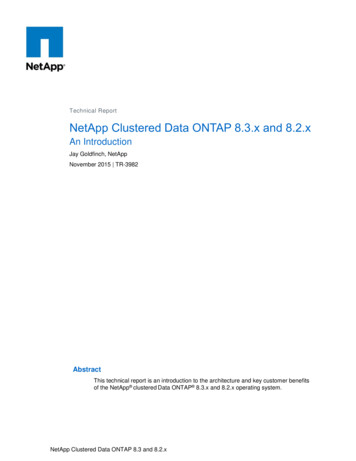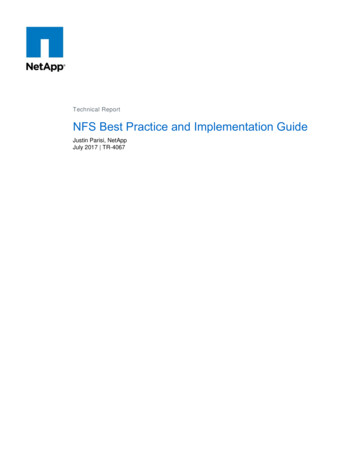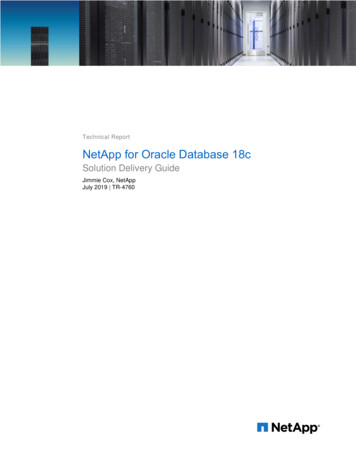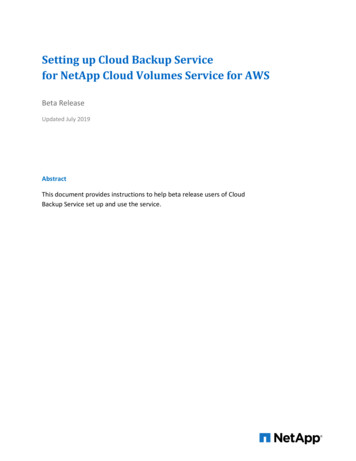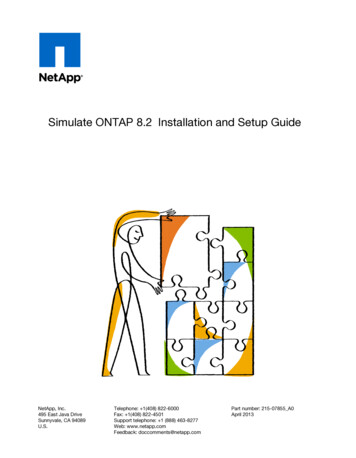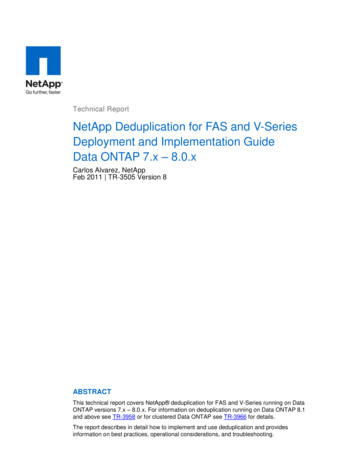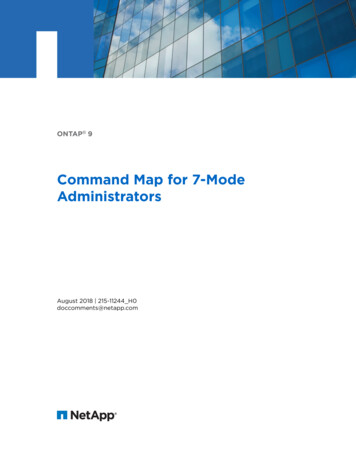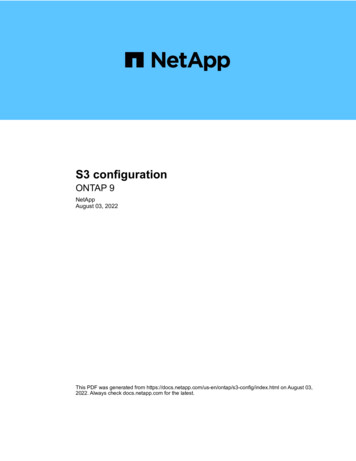
Transcription
Get startedCloud Volumes ONTAPNetAppJuly 03, 2022This PDF was generated from volumesontap/concept-overview-cvo.html on July 03, 2022. Always check docs.netapp.com for the latest.
Table of ContentsGet started . . . . . . . . . . . . . . . . . . . . . . . . . . . . . . . . . . . . . . . . . . . . . . . . . . . . . . . . . . . . . . . . . . . . . . . . . . . . . . 1Learn about Cloud Volumes ONTAP . . . . . . . . . . . . . . . . . . . . . . . . . . . . . . . . . . . . . . . . . . . . . . . . . . . . . . . . 1Get started in Amazon Web Services . . . . . . . . . . . . . . . . . . . . . . . . . . . . . . . . . . . . . . . . . . . . . . . . . . . . . . . 2Get started in Microsoft Azure . . . . . . . . . . . . . . . . . . . . . . . . . . . . . . . . . . . . . . . . . . . . . . . . . . . . . . . . . . . . 62Get started in Google Cloud. . . . . . . . . . . . . . . . . . . . . . . . . . . . . . . . . . . . . . . . . . . . . . . . . . . . . . . . . . . . . . 91
Get startedLearn about Cloud Volumes ONTAPCloud Volumes ONTAP enables you to optimize your cloud storage costs andperformance while enhancing data protection, security, and compliance.Cloud Volumes ONTAP is a software-only storage appliance that runs ONTAP data management software inthe cloud. It provides enterprise-grade storage with the following key features: Storage efficienciesLeverage built-in data deduplication, data compression, thin provisioning, and cloning to minimize storagecosts. High availabilityEnsure enterprise reliability and continuous operations in case of failures in your cloud environment. Data protectionCloud Volumes ONTAP leverages SnapMirror, NetApp’s industry-leading replication technology, to replicateon-premises data to the cloud so it’s easy to have secondary copies available for multiple use cases.Cloud Volumes ONTAP also integrates with Cloud Backup to deliver backup and restore capabilities forprotection, and long-term archive of your cloud data.Learn more about Cloud Backup Data tieringSwitch between high and low-performance storage pools on-demand without taking applications offline. Application consistencyEnsure consistency of NetApp Snapshot copies using NetApp SnapCenter.Learn more about SnapCenter Data securityCloud Volumes ONTAP supports data encryption and provides protection against viruses and ransomware. Privacy compliance controlsIntegration with Cloud Data Sense helps you understand data context and identify sensitive data.Learn more about Cloud Data SenseLicenses for ONTAP features are included with Cloud Volumes ONTAP.View supported Cloud Volumes ONTAP configurations1
Learn more about Cloud Volumes ONTAPGet started in Amazon Web ServicesQuick start for Cloud Volumes ONTAP in AWSGet started with Cloud Volumes ONTAP in AWS in a few steps.Create a ConnectorIf you don’t have a Connector yet, an Account Admin needs to create one. Learn how to create a Connector inAWS.When you create your first Cloud Volumes ONTAP working environment, Cloud Manager prompts you todeploy a Connector if you don’t have one yet.Plan your configurationCloud Manager offers preconfigured packages that match your workload requirements, or you can create yourown configuration. If you choose your own configuration, you should understand the options available to you.Learn more.Set up your networkinga. Ensure that your VPC and subnets will support connectivity between the Connector and Cloud VolumesONTAP.b. Enable outbound internet access from the target VPC so the Connector and Cloud Volumes ONTAP cancontact several endpoints.This step is important because the Connector can’t manage Cloud Volumes ONTAP without outboundinternet access. If you need to limit outbound connectivity, refer to the list of endpoints for the Connectorand Cloud Volumes ONTAP.c. Set up a VPC endpoint to the S3 service.A VPC endpoint is required if you want to tier cold data from Cloud Volumes ONTAP to low-cost objectstorage.Learn more about networking requirements.Set up the AWS KMSIf you want to use Amazon encryption with Cloud Volumes ONTAP, then you need to ensure that an activeCustomer Master Key (CMK) exists. You also need to modify the key policy for each CMK by adding the IAMrole that provides permissions to the Connector as a key user. Learn more.Launch Cloud Volumes ONTAP using Cloud Manager2
Click Add Working Environment, select the type of system that you would like to deploy, and complete thesteps in the wizard. Read step-by-step instructions.Related links Creating a Connector from Cloud Manager Launching a Connector from the AWS Marketplace Installing the Connector software on a Linux host What Cloud Manager does with AWS permissionsPlan your Cloud Volumes ONTAP configuration in AWSWhen you deploy Cloud Volumes ONTAP in AWS, you can choose a preconfiguredsystem that matches your workload requirements, or you can create your ownconfiguration. If you choose your own configuration, you should understand the optionsavailable to you.Choose a Cloud Volumes ONTAP licenseSeveral licensing options are available for Cloud Volumes ONTAP. Each option enables you to choose aconsumption model that meets your needs. Learn about licensing options for Cloud Volumes ONTAP Learn how to set up licensingChoose a supported regionCloud Volumes ONTAP is supported in most AWS regions. View the full list of supported regions.Newer AWS regions must be enabled before you can create and manage resources in those regions. Learnhow to enable a region.Choose a supported instanceCloud Volumes ONTAP supports several instance types, depending on the license type that you choose.Supported configurations for Cloud Volumes ONTAP in AWSUnderstand storage limitsThe raw capacity limit for a Cloud Volumes ONTAP system is tied to the license. Additional limits impact thesize of aggregates and volumes. You should be aware of these limits as you plan your configuration.Storage limits for Cloud Volumes ONTAP in AWSSize your system in AWSSizing your Cloud Volumes ONTAP system can help you meet requirements for performance and capacity. Youshould be aware of a few key points when choosing an instance type, disk type, and disk size:Instance type Match your workload requirements to the maximum throughput and IOPS for each EC2 instance type.3
If several users write to the system at the same time, choose an instance type that has enough CPUs tomanage the requests. If you have an application that is mostly reads, then choose a system with enough RAM. AWS Documentation: Amazon EC2 Instance Types AWS Documentation: Amazon EBS–Optimized InstancesEBS disk typeAt a high level, the differences between EBS disk types are as follows. To learn more about the use casesfor EBS disks, refer to AWS Documentation: EBS Volume Types. General Purpose SSD (gp3) disks are the lowest-cost SSDs that balance cost and performance for abroad range of workloads. Performance is defined in terms of IOPS and throughput. gp3 disks aresupported with Cloud Volumes ONTAP 9.7 and later.When you select a gp3 disk, Cloud Manager fills in default IOPS and throughput values that provideperformance that is equivalent to a gp2 disk based on the selected disk size. You can increase thevalues to get better performance at a higher cost, but we do not support lower values because it canresult in inferior performance. In short, stick with the default values or increase them. Don’t lower them.Learn more about gp3 disks and their performance.Note that Cloud Volumes ONTAP supports the Amazon EBS Elastic Volumes feature with gp3 disks.Learn more about Elastic Volumes support. General Purpose SSD (gp2) disks balance cost and performance for a broad range of workloads.Performance is defined in terms of IOPS. Provisioned IOPS SSD (io1) disks are for critical applications that require the highest performance at ahigher cost.Note that Cloud Volumes ONTAP supports the Amazon EBS Elastic Volumes feature with io1 disks.Learn more about Elastic Volumes support. Throughput Optimized HDD (st1) disks are for frequently accessed workloads that require fast andconsistent throughput at a lower price.Tiering data to object storage is not recommended when using Throughput OptimizedHDDs (st1).EBS disk sizeIf you choose a configuration that doesn’t support the Amazon EBS Elastic Volumes feature, then you needto choose an initial disk size when you launch a Cloud Volumes ONTAP system. After that, you can letCloud Manager manage a system’s capacity for you, but if you want to create aggregates yourself, beaware of the following: All disks in an aggregate must be the same size. The performance of EBS disks is tied to disk size. The size determines the baseline IOPS andmaximum burst duration for SSD disks and the baseline and burst throughput for HDD disks. Ultimately, you should choose the disk size that gives you the sustained performance that you need. Even if you do choose larger disks (for example, six 4 TiB disks), you might not get all of the IOPSbecause the EC2 instance can reach its bandwidth limit.4
For more details about EBS disk performance, refer to AWS Documentation: EBS Volume Types.As noted above, choosing a disk size is not supported with Cloud Volumes ONTAP configurations thatsupport the Amazon EBS Elastic Volumes feature. Learn more about Elastic Volumes support.Watch the following video for more details about sizing your Cloud Volumes ONTAP system in AWS:View default system disksIn addition to the storage for user data, Cloud Manager also purchases cloud storage for Cloud VolumesONTAP system data (boot data, root data, core data, and NVRAM). For planning purposes, it might help foryou to review these details before you deploy Cloud Volumes ONTAP.View the default disks for Cloud Volumes ONTAP system data in AWS.The Connector also requires a system disk. View details about the Connector’s defaultconfiguration.Prepare to deploy Cloud Volumes ONTAP in an AWS OutpostIf you have an AWS Outpost, you can deploy Cloud Volumes ONTAP in that Outpost by selecting the OutpostVPC in the Working Environment wizard. The experience is the same as any other VPC that resides in AWS.Note that you will need to first deploy a Connector in your AWS Outpost.There are a few limitations to point out: Only single node Cloud Volumes ONTAP systems are supported at this time The EC2 instances that you can use with Cloud Volumes ONTAP are limited to what’s available in yourOutpost5
Only General Purpose SSDs (gp2) are supported at this timeCollect networking informationWhen you launch Cloud Volumes ONTAP in AWS, you need to specify details about your VPC network. Youcan use a worksheet to collect the information from your administrator.Single node or HA pair in a single AZAWS informationYour valueRegionVPCSubnetSecurity group (if using yourown)HA pair in multiple AZsAWS informationYour valueRegionVPCSecurity group (if using yourown)Node 1 availability zoneNode 1 subnetNode 2 availability zoneNode 2 subnetMediator availability zoneMediator subnetKey pair for the mediatorFloating IP address for clustermanagement portFloating IP address for data onnode 1Floating IP address for data onnode 2Route tables for floating IPaddressesChoose a write speedCloud Manager enables you to choose a write speed setting for Cloud Volumes ONTAP. Before you choose awrite speed, you should understand the differences between the normal and high settings and risks and6
recommendations when using high write speed. Learn more about write speed.Choose a volume usage profileONTAP includes several storage efficiency features that can reduce the total amount of storage that you need.When you create a volume in Cloud Manager, you can choose a profile that enables these features or a profilethat disables them. You should learn more about these features to help you decide which profile to use.NetApp storage efficiency features provide the following benefits:Thin provisioningPresents more logical storage to hosts or users than you actually have in your physical storage pool.Instead of preallocating storage space, storage space is allocated dynamically to each volume as data iswritten.DeduplicationImproves efficiency by locating identical blocks of data and replacing them with references to a singleshared block. This technique reduces storage capacity requirements by eliminating redundant blocks ofdata that reside in the same volume.CompressionReduces the physical capacity required to store data by compressing data within a volume on primary,secondary, and archive storage.Set up your networkingNetworking requirements for Cloud Volumes ONTAP in AWSCloud Manager handles the set up of networking components for Cloud Volumes ONTAP,such as IP addresses, netmasks, and routes. You need to make sure that outboundinternet access is available, that enough private IP addresses are available, that the rightconnections are in place, and more.General requirementsThe following requirements must be met in AWS.Outbound internet access for Cloud Volumes ONTAP nodesCloud Volumes ONTAP nodes require outbound internet access to send messages to NetApp AutoSupport,which proactively monitors the health of your storage.Routing and firewall policies must allow AWS HTTP/HTTPS traffic to the following endpoints so Cloud VolumesONTAP can send AutoSupport messages: https://support.netapp.com/aods/asupmessage supIf you have a NAT instance, you must define an inbound security group rule that allows HTTPS traffic from theprivate subnet to the internet.Learn how to configure AutoSupport.7
Outbound internet access for the HA mediatorThe HA mediator instance must have an outbound connection to the AWS EC2 service so it can assist withstorage failover. To provide the connection, you can add a public IP address, specify a proxy server, or use amanual option.The manual option can be a NAT gateway or an interface VPC endpoint from the target subnet to the AWSEC2 service. For details about VPC endpoints, refer to AWS Documentation: Interface VPC Endpoints (AWSPrivateLink).Private IP addressesCloud Manager automatically allocates the required number of private IP addresses to Cloud Volumes ONTAP.You need to ensure that your networking has enough private IP addresses available.The number of LIFs that Cloud Manager allocates for Cloud Volumes ONTAP depends on whether you deploya single node system or an HA pair. A LIF is an IP address associated with a physical port.IP addresses for a single node systemCloud Manager allocates 6 IP addresses to a single node system: Cluster management LIF Node management LIF Intercluster LIF NAS data LIF iSCSI data LIF Storage VM management LIFA storage VM management LIF is used with management tools like SnapCenter.IP addresses for HA pairsHA pairs require more IP addresses than a single node system does. These IP addresses are spread acrossdifferent ethernet interfaces, as shown in the following image:8
The number of private IP addresses required for an HA pair depends on which deployment model you choose.An HA pair deployed in a single AWS Availability Zone (AZ) requires 15 private IP addresses, while an HA pairdeployed in multiple AZs requires 13 private IP addresses.The following tables provide details about the LIFs that are associated with each private IP address.LIFs for HA pairs in a single AZLIFInterfaceNodePurposeCluster management eth0node 1Administrative management of the entirecluster (HA pair).Node managementeth0node 1 and node 2Administrative management of a node.Interclustereth0node 1 and node 2Cross-cluster communication, backup, andreplication.NAS dataeth0node 1Client access over NAS protocols.iSCSI dataeth0node 1 and node 2Client access over the iSCSI protocol.9
LIFInterfaceNodePurposeCluster connectivityeth1node 1 and node 2Enables the nodes to communicate witheach other and to move data within thecluster.HA connectivityeth2node 1 and node 2Communication between the two nodes incase of failover.RSM iSCSI trafficeth3node 1 and node 2RAID SyncMirror iSCSI traffic, as well ascommunication between the two CloudVolumes ONTAP nodes and the mediator.Mediatoreth0MediatorA communication channel between thenodes and the mediator to assist in storagetakeover and giveback processes.LIFs for HA pairs in multiple AZsLIFInterfaceNodePurposeNode managementeth0node 1 and node 2Administrative management of a node.Interclustereth0node 1 and node 2Cross-cluster communication, backup, andreplication.iSCSI dataeth0node 1 and node 2Client access over the iSCSI protocol.This LIF also manages the migration offloating IP addresses between nodes.Cluster connectivityeth1node 1 and node 2Enables the nodes to communicate witheach other and to move data within thecluster.HA connectivityeth2node 1 and node 2Communication between the two nodes incase of failover.RSM iSCSI trafficeth3node 1 and node 2RAID SyncMirror iSCSI traffic, as well ascommunication between the two CloudVolumes ONTAP nodes and the mediator.Mediatoreth0MediatorA communication channel between thenodes and the mediator to assist in storagetakeover and giveback processes.When deployed in multiple Availability Zones, several LIFs are associated with floating IPaddresses, which don’t count against the AWS private IP limit.Security groupsYou do not need to create security groups because Cloud Manager does that for you. If you need to use yourown, refer to Security group rules.Connection for data tieringIf you want to use EBS as a performance tier and AWS S3 as a capacity tier, you must ensure that CloudVolumes ONTAP has a connection to S3. The best way to provide that connection is by creating a VPC10
Endpoint to the S3 service. For instructions, see AWS Documentation: Creating a Gateway Endpoint.When you create the VPC Endpoint, be sure to select the region, VPC, and route table that corresponds to theCloud Volumes ONTAP instance. You must also modify the security group to add an outbound HTTPS rule thatenables traffic to the S3 endpoint. Otherwise, Cloud Volumes ONTAP cannot connect to the S3 service.If you experience any issues, see AWS Support Knowledge Center: Why can’t I connect to an S3 bucket usinga gateway VPC endpoint?Connections to ONTAP systemsTo replicate data between a Cloud Volumes ONTAP system in AWS and ONTAP systems in other networks,you must have a VPN connection between the AWS VPC and the other network—for example, your corporatenetwork. For instructions, see AWS Documentation: Setting Up an AWS VPN Connection.DNS and Active Directory for CIFSIf you want to provision CIFS storage, you must set up DNS and Active Directory in AWS or extend your onpremises setup to AWS.The DNS server must provide name resolution services for the Active Directory environment. You canconfigure DHCP option sets to use the default EC2 DNS server, which must not be the DNS server used by theActive Directory environment.For instructions, refer to AWS Documentation: Active Directory Domain Services on the AWS Cloud: QuickStart Reference Deployment.VPC sharingStarting with the 9.11.1 release, Cloud Volumes ONTAP HA pairs are supported in AWS with VPC sharing.VPC sharing enables your organization to share subnets with other AWS accounts. To use this configuration,you must set up your AWS environment and then deploy the HA pair using the API.Learn how to deploy an HA pair in a shared subnet.Requirements for HA pairs in multiple AZsAdditional AWS networking requirements apply to Cloud Volumes ONTAP HA configurations that use multipleAvailability Zones (AZs). You should review these requirements before you launch an HA pair because youmust enter the networking details in Cloud Manager when you create the working environment.To understand how HA pairs work, see High-availability pairs.Availability ZonesThis HA deployment model uses multiple AZs to ensure high availability of your data. You should use adedicated AZ for each Cloud Volumes ONTAP instance and the mediator instance, which provides acommunication channel between the HA pair.A subnet should be available in each Availability Zone.Floating IP addresses for NAS data and cluster/SVM managementHA configurations in multiple AZs use floating IP addresses that migrate between nodes if failures occur.They are not natively accessible from outside the VPC, unless you set up an AWS transit gateway.One floating IP address is for cluster management, one is for NFS/CIFS data on node 1, and one is for11
NFS/CIFS data on node 2. A fourth floating IP address for SVM management is optional.A floating IP address is required for the SVM management LIF if you use SnapDrive forWindows or SnapCenter with the HA pair.You need to enter the floating IP addresses in Cloud Manager when you create a Cloud Volumes ONTAPHA working environment. Cloud Manager allocates the IP addresses to the HA pair when it launches thesystem.The floating IP addresses must be outside of the CIDR blocks for all VPCs in the AWS region in which youdeploy the HA configuration. Think of the floating IP addresses as a logical subnet that’s outside of theVPCs in your region.The following example shows the relationship between floating IP addresses and the VPCs in an AWSregion. While the floating IP addresses are outside the CIDR blocks for all VPCs, they’re routable tosubnets through route tables.12
Cloud Manager automatically creates static IP addresses for iSCSI access and for NASaccess from clients outside the VPC. You don’t need to meet any requirements for thesetypes of IP addresses.Transit gateway to enable floating IP access from outside the VPCIf needed, set up an AWS transit gateway to enable access to an HA pair’s floating IP addresses fromoutside the VPC where the HA pair resides.Route tablesAfter you specify the floating IP addresses in Cloud Manager, you are then prompted to select the routetables that should include routes to the floating IP addresses. This enables client access to the HA pair.If you have just one route table for the subnets in your VPC (the main route table), then Cloud Managerautomatically adds the floating IP addresses to that route table. If you have more than one route table, it’svery important to select the correct route tables when launching the HA pair. Otherwise, some clients mightnot have access to Cloud Volumes ONTAP.For example, you might have two subnets that are associated with different route tables. If you select routetable A, but not route table B, then clients in the subnet associated with route table A can access the HApair, but clients in the subnet associated with route table B can’t.For more information about route tables, refer to AWS Documentation: Route Tables.Connection to NetApp management toolsTo use NetApp management tools with HA configurations that are in multiple AZs, you have two connectionoptions:1. Deploy the NetApp management tools in a different VPC and set up an AWS transit gateway. Thegateway enables access to the floating IP address for the cluster management interface from outsidethe VPC.2. Deploy the NetApp management tools in the same VPC with a similar routing configuration as NASclients.Example HA configurationThe following image illustrates the networking components specific to an HA pair in multiple AZs: threeAvailability Zones, three subnets, floating IP addresses, and a route table.13
Requirements for the ConnectorSet up your networking so that the Connector can manage resources and processes within your public cloudenvironment. The most important step is ensuring outbound internet access to various endpoints.If your network uses a proxy server for all communication to the internet, you can specify theproxy server from the Settings page. Refer to Configuring the Connector to use a proxy server.Connection to target networksA Connector requires a network connection to the VPCs and VNets in which you want to deploy CloudVolumes ONTAP.14
For example, if you install a Connector in your corporate network, then you must set up a VPN connection tothe VPC or VNet in which you launch Cloud Volumes ONTAP.Outbound internet accessThe Connector requires outbound internet access to manage resources and processes within your public etapp.comTo obtain licensing information and to send AutoSupportmessages to NetApp support.https://*.cloudmanager.cloud.netapp.comTo provide SaaS features and services within .ioTo upgrade the Connector and its Docker components.https://*.blob.core.windows.netSetting up an AWS transit gateway for HA pairs in multiple AZsSet up an AWS transit gateway to enable access to an HA pair’s floating IP addressesfrom outside the VPC where the HA pair resides.When a Cloud Volumes ONTAP HA configuration is spread across multiple AWS Availability Zones, floating IPaddresses are required for NAS data access from within the VPC. These floating IP addresses can migratebetween nodes when failures occur, but they are not natively accessible from outside the VPC. Separateprivate IP addresses provide data access from outside the VPC, but they don’t provide automatic failover.Floating IP addresses are also required for the cluster management interface and the optional SVMmanagement LIF.If you set up an AWS transit gateway, you enable access to the floating IP addresses from outside the VPCwhere the HA pair resides. That means NAS clients and NetApp management tools outside the VPC canaccess the floating IPs.Here’s an example that shows two VPCs connected by a transit gateway. An HA system resides in one VPC,while a client resides in the other. You could then mount a NAS volume on the client using the floating IPaddress.15
The following steps illustrate how to set up a similar configuration.Steps1. Create a transit gateway and attach the VPCs to the gateway.2. Associate the VPCs with the transit gateway route table.a. In the VPC service, click Transit Gateway Route Tables.b. Select the route table.c. Click Associations and then select Create association.d. Choose the attachments (the VPCs) to associate and then click Create association.3. Create routes in the transit gateway’s route table by specifying the HA pair’s floating IP addresses.You can find the floating IP addresses on the Working Environment Information page in Cloud Manager.Here’s an example:16
The following sample image shows the route table for the transit gateway. It includes routes to the CIDRblocks of the two VPCs and four floating IP addresses used by Cloud Volumes ONTAP.4. Modify the route table of VPCs that need to access the floating IP addresses.a. Add route entries to the floating IP addresses.b. Add a route entry to the CIDR block of the VPC where the HA pair resides.The following sample image shows the route table for VPC 2, which includes routes to VPC 1 and thefloating IP addresses.17
5. Modify the route table for the HA pair’s VPC by adding a route to the VPC that needs access to the floatingIP addresses.This step is important because it completes the routing between the VPCs.The following sample image shows the route table for VPC 1. It includes a route to the floating IPaddresses and to VPC 2, which is where a client resides. Cloud Manager automatically added the floatingIPs to the route table when it deployed the HA pair.6. Mount volumes to clients using the floating IP address.You can find the correct IP address in Cloud Manager by selecting a volume and clicking MountCommand.18
7. If you’re mounting an NFS volume, configure the export policy to match the subnet of the client VPC.Learn how to edit a volume.Related links High-availability pairs in AWS Networking requirements for Cloud Volumes ONTAP in AWSDeploy an HA pair in a shared subnetStarting with the 9.11.1 release, Cloud Volumes ONTAP HA pairs are supported in AWSwith VPC sharing. VPC sharing enables your organization to share subnets with otherAWS accounts. To use this configuration, you must set up your AWS environment andthen deploy the HA pair using the API.With VPC sharing, a Cloud Volumes ONTAP HA configuration is spread across two accounts: The VPC owner account, which owns the networking (the VPC, subnets, route tables, and Cloud VolumesONTAP security group) The participant account, where the EC2 instances are deployed in shared subnets (this includes the twoHA nodes and the mediator)In the case of a Cloud Volumes ONTAP HA configuration that is deployed across multiple Availability Zones,the HA mediator needs specific permissions to write to the route tables in the VPC owner account. You need toprovide those permissions by setting up an IAM role that the mediator can assume.The following image shows the components involved this deployment:19
As described in the steps below, you’ll need to share the subnets with the participant account, and then createthe IAM role and security group in the VPC owner account.When you create the Cloud Volumes ONTAP working environment, Cloud Manager automatically creates andattaches an IAM role to the mediator. This role assumes the IAM role that you created in the VPC owneraccount in order to make changes to the route tables associated with the HA pair.Steps1. Share the subnets in the VPC owner account with the participant account.This step is required to deploy the HA pair in shared subnets.AWS documentation: Share a subnet20
2. In the VPC owner account, create a security group for Cloud Volumes ONTAP.Refer to the security group rules for Cloud Volumes ONTAP. Note that you don’t need to create a securitygroup for the HA mediator. Cloud Manager does that for you.3. In the VPC owner account, create an IAM role that includes the following permissions:Action": ReplaceRoute","
Cloud Volumes ONTAP enables you to optimize your cloud storage costs and performance while enhancing data protection, security, and compliance. Cloud Volumes ONTAP is a software-only storage appliance that runs ONTAP data management software in the cloud. It provides enterprise-grade storage with the following key features: Storage efficiencies

